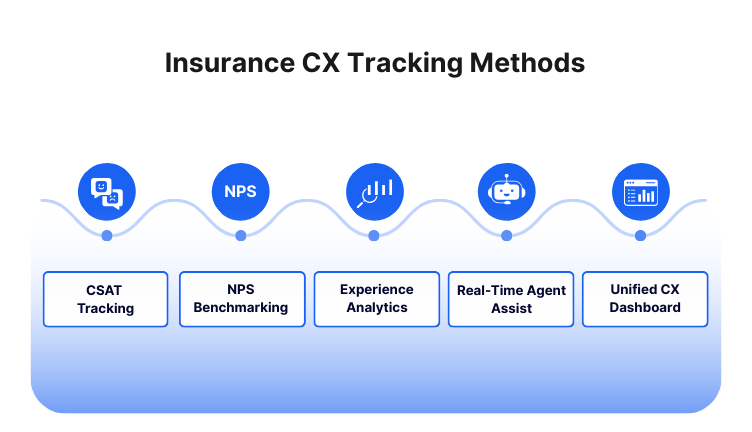In an industry where the average customer retention rate sits around 76%, and companies excelling in experience see up to 19% higher retention, it’s clear: delivering on insurance customer experience isn’t a nice‑to‑have, it’s a competitive imperative. If your policyholders feel neglected, misheard, or mis‑served, the risk of churn is not just real, it’s expensive.
In this blog, you’ll discover 5 proven ways to track insurance customer experience, from CSAT and NPS benchmarks to sentiment analytics, real‑time agent support and unified CX dashboards.
You’ll also get a practical sneak peek of how the full‑stack solution from Convin ties it all together.
Expect actionable insights, real metrics and a clear path to turning experience into retention, revenue and policy‑holder loyalty.
Start measuring your customer experience using Convin’s analytics.

Measure Satisfaction With CSAT Tracking insurance Customers Trust
Customer satisfaction (CSAT) remains one of the most direct reflections of how your policyholders feel about your service, especially in high‑stakes segments like claims or policy renewals.
A single openly‑asked question (“How satisfied are you with this interaction?”) can flag root problems in your insurance customer experience.
Choosing the right touchpoints, collecting feedback quickly, and embedding CSAT into your operations creates early warning lights that protect retention and loyalty.
1. What CSAT Means for Customer Satisfaction Metrics
CSAT is often captured via a simple survey: e.g., “On a scale of 1‑5, how satisfied are you with your interaction?” But in insurance, the small details matter.
A claim payout delay, confusing renewal message, or bot‑only interaction can all depress CSAT even when policy coverage is strong.
Industry benchmarks suggest that average CSAT scores vary widely, but if you’re tracking it across product lines, service types, and agent cohorts, you get a sharper view of your insurance customer experience.
Effective CSAT tracking enables you to:
- Monitor service touchpoints and isolate friction hotspots (call wait time, agent empathy, claim clarity).
- Set internal targets tied to agent/team performance, instead of relying solely on annual survey snapshots.
- Link CSAT to retention: insurers who consistently measure CSAT catch service drop‑offs early and reduce churn.
In short, CSAT becomes a frontline metric for insurance customer experience—not just a lagging indicator but a tool for proactive management.
2. Tools for CSAT Tracking insurance Teams Trust
This is where Convin shines. With its post‑interaction feedback tools embedded across calls, chats and emails, Convin’s platform automates CSAT collection, trending and drill‑down analytics.
Convin’s feedback tooling enables insurers to continuously collect, analyse and act on customer input, closing service gaps and driving stronger insurance customer experience outcomes. Key features include:
- Automated triggers for CSAT surveys immediately after agent interactions.
- Real‑time dashboards for CSAT by agent, product, region, even policy type.
- Correlation views: link CSAT drops to specific agents, scripts, or channels, enabling targeted coaching.
- Integration with CRM and contact‑centre tech so feedback isn’t siloed.
When CSAT tracking is embedded into operations, as opposed to treated like an occasional survey, you begin to lift satisfaction systematically.
It becomes a core ingredient for building the broader insurance customer experience.
Use Insurance NPS Benchmarks to Gauge Loyalty
Tracking CSAT tells you how satisfied someone is today. But loyalty, whether a customer will renew, buy another product, or refer you, is captured by Net Promoter Score (NPS).
For insurers, that becomes a critical barometer of the overall insurance customer experience. Insight: the insurance industry average NPS hovers around 35.
When your NPS lags this benchmark, you’re at higher risk of inactivity, attrition or price‑based churn.
1. Understanding Insurance NPS Benchmarks
NPS is calculated as: %Promoters minus %Detractors (scale −100 to +100).
In insurance, what matters is your relative standing and trend. For example:
- If you’re scoring below ~30 in life insurance or below ~35 in auto, you’re in the “average” zone.
- A top‑tier insurer might score 50+. That’s the zone where referral, retention and revenue upside intersect.
Using NPS in the context of insurance customer experience empowers you to:
- Benchmark yourself against peers and identify where you’re behind.
- Segment NPS by product, region, claim type or channel to find out which groups are more loyal.
- Link NPS to lifetime value, renewals, and cross‑sell potential.
In short, NPS isn’t just a vanity metric, it’s a strategic metric for insurer loyalty and experience.
2. Improving NPS With Experience Analytics Insurance Tools
Here’s how the analytics layer amplifies NPS work. With tools from Convin’s Voice‑of‑Customer and conversation‑intelligence stack, insurers can:
- Mine call, chat and email transcripts for sentiment, emotion and intent (revealing why detractors exist).
- Track shifts in NPS over time at micro‑levels: agent teams, campaigns, product launches.
- Close the loop, route feedback from low‑scoring customers into escalation, coaching or remediation workflows.
Convin’s case‑studies show how automation and AI reduce manual survey load and deliver faster insights.
For insurers looking to improve their insurance customer experience, using NPS as a structural guide, and backing it with analytics, delivers insight and action at scale.
Boost your NPS with Convin’s experience analytics platform now
This blog is just the start.
Unlock the power of Convin’s AI with a live demo.

Leverage Experience Analytics Insurance Teams Need Most
Measuring CSAT and NPS provides snapshots. Experience analytics is the lens through which you see the real stories behind the numbers.
For insurers committed to elevating insurance customer experience, analytics become indispensable, revealing hidden patterns in interactions and guiding strategic investments.

1. Sentiment Analysis in Experience Analytics Insurance Tech
Analytics go beyond “score” and into “why”. With sentiment and emotion tracking across voice and text, insurers identify frustration, confusion, or satisfaction in real‑time. For example:
According to Convin, companies using conversational AI for claims service report faster claim resolution and higher service satisfaction. Features include:
- Tone and emotion detection (how an agent responded, was the customer irritated?).
- Real‑time prompts (agent is alerted if the call is going poorly).
- Trend detection (are sentiment scores dropping in a specific product region?).
In the context of insurance customer experience, sentiment analytics allow you to convert raw interaction data into insight: agent script gaps, process breakdowns, policyholder confusion zones.
This builds deeper understanding and functional improvement beyond “the number”.
2. Spot Hidden Patterns in Customer Satisfaction Metrics
When analytics tools ingest hundreds of thousands of calls, chats, and emails, patterns emerge that humans cannot catch manually. Some examples:
- A spike in negative CSAT or NPS within 30 days of a product launch, triggering investigation into script changes.
- Certain regions where sentiment drops consistently on renewal calls, indicating training or localization needs.
- Agents whose sentiment and CSAT outcomes underperform, despite standard KPIs, pointing to coaching or process failure.
Convin’s analytics also support proactive insights: the policy‑renewal case study showed a 28% drop in lapse rates when feedback loops and analytics were embedded.
By turning unsorted interaction data into strategic dashboards, you begin to lift your insurance customer experience from reactive fixes to proactive strategy.
Reveal hidden CX patterns using Convin’s advanced analytics suite
Enable Agents With Real‑Time Assist for On‑Call CX Boost
Tracking and analytics are critical, but the human interface still matters most. In insurance, every agent interaction affects your policyholder’s perception, loyalty and lifetime value.
Embedding tools that assist agents in real time converts measurement into action. That’s where Convin’s stack becomes instrumental.

1. Convin’s Real‑Time Agent Assist Capabilities
Convin’s Real‑Time Agent Assist platform listens live to agent‑customer interactions and intervenes: offering prompts, highlighting risk, compliance cues, or next‑best actions.
Agents become more confident, accurate, and productive with Convin’s AI call‑handling insurance. How this enhances insurance customer experience:
- Live prompts reduce agent processing time, maintain script consistency and avoid errors, boosting first‑call resolution.
- Supervisor assist and live alerts highlight calls going off‑track before detractor sentiments solidify.
- Coaching triggered by real interactions, not just supervisor spot‑checks, accelerates agent competence and satisfaction.
2. CSAT and NPS Lift From On‑Call Assistance
The benefit? Dashboards for satisfaction and loyalty show consistent improvement. While specific agent‑level lift numbers vary,
Convin references that conversational AI and agent assist raise agent productivity by up to 40%.
In effect, when your interface (agent) is better equipped, fewer service failures occur, CSAT goes up, NPS improves, and your overall insurance customer experience grows stronger.
For insurers, real‑time assist tools shift the paradigm: from measuring service after the fact to elevating service mid‑interaction.
Empower every agent with Convin’s real-time call assist today
Build a Unified CX Dashboard for End‑to‑End Visibility
Tracking multiple metrics separately, CSAT, NPS, sentiment, agent performance, is common. But the real power lies in pulling them together into a unified view.
That’s the final linchpin in the five‑way strategy to enhance insurance customer experience.
1. Consolidating All Customer Satisfaction Metrics
Imagine one dashboard that shows you:
- Current CSAT scores, by team and product.
- NPS by segment, with trend lines.
- Sentiment mapping across calls and chats.
- Agent‑performance metrics and root‑cause drill‑downs.
- Business outcomes: lapses, renewals, claims satisfaction.
Having this holistic view means your executive team can monitor customer‑experience health in real time, spot emerging issues, and make strategic investment or process decisions with confidence.
2. Convin’s Role in Driving Unified CX Analytics
Convin’s platform is built for insurance operations: voice and text data integration, real‑time and post‑call analytics, insights into renewals, claims, persistence and agent behavior.
Their solution overview emphasises policy‑renewals, automated reminders, upsell campaigns and full contact‑centre support.
By adopting a unified CX dashboard approach, insurers are better positioned to move from “we measure” to “we act, we improve, we sustain” across the full insurance customer experience.
For executives and CX leaders, this final step transforms metrics into management.
Unify all your CX metrics with Convin’s centralized dashboard
Invest in the Right Tools to Win Customer Experience
Improving insurance customer experience is no longer about surveys and scripts alone. It demands real-time insights, AI-driven analytics, and tools that move the needle, across CSAT, NPS, sentiment, and agent performance.
The five strategies we explore, CSAT tracking, NPS benchmarking, experience analytics, on-call assistance, and unified dashboards, aren’t just methods; they’re must-haves for insurers looking to retain, grow, and delight their policyholders.
For insurers ready to take action, Convin offers a unified platform that delivers on every front, feedback, analytics, agent support, and executive insight, all built with insurance in mind.
It’s the kind of solution that shifts CX from operational reporting to strategic advantage. Ready to see the impact on your policyholder experience? Start your journey with Convin today.
FAQ
1. What is the best way to measure customer experience?
The best way to measure customer experience in insurance is by tracking a combination of CSAT (Customer Satisfaction), NPS (Net Promoter Score), sentiment analysis, and real-time interaction analytics. These metrics offer both quantitative and emotional insights. Platforms like Convin enhance this by automating feedback collection, analyzing sentiment from conversations, and surfacing CX patterns insurers often miss.
2. What are the 5 C's of insurance?
The 5 C’s of insurance are: Coverage, Cost, Claims, Customer Service, and Consistency. These pillars define an insurer’s ability to provide value and retain customers. In today’s competitive market, customer service and consistency are increasingly driven by technology and real-time experience tracking.
3. What is the 80/20 rule in insurance?
In insurance, the 80/20 rule refers to the idea that 80% of revenue often comes from 20% of customers. It highlights the importance of identifying and nurturing high-value policyholders. Measuring and optimizing insurance customer experience helps retain these top customers and maximize lifetime value.
4. What are the 5 key performance indicators for customer service?
Top KPIs for customer service in insurance include:
- CSAT Score
- Net Promoter Score (NPS)
- First Contact Resolution (FCR)
- Average Handling Time (AHT)
- Customer Sentiment Score
Convin’s platform captures and analyzes all five, helping insurers improve service quality and policyholder satisfaction.









.avif)